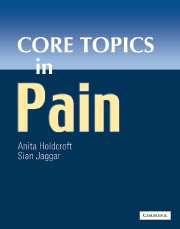Book contents
- Frontmatter
- Contents
- Contributors
- Preface
- Acknowledgements
- Foreword
- General abbreviations
- Basic science abbreviations
- PART 1 BASIC SCIENCE
- PART 2 PAIN ASSESSMENT
- Section 2a Pain measurement
- Section 2b Diagnostic strategies
- PART 3 PAIN IN THE CLINICAL SETTING
- Section 3a Clinical presentations
- Section 3b Pain syndromes
- 19 Myofascial/musculoskeletal pain
- 20 Neuropathic pain
- 21 Visceral nociception and pain
- 22 The management of low back pain
- 23 Cancer pain
- 24 Post-operative pain
- 25 Complex regional pain syndrome
- 26 Uncommon pain syndromes
- 27 Pain in children
- 28 Pain in the elderly
- 29 Gender and pain
- PART 4 THE ROLE OF EVIDENCE IN PAIN MANAGEMENT
- PART 5 TREATMENT OF PAIN
- Section 5a General Principles
- Section 5b Physical treatments
- Section 5c Pharmacology
- Section 5d Psychosocial
- PART 6 SUMMARIES
- Glossary
- Index
23 - Cancer pain
from Section 3b - Pain syndromes
Published online by Cambridge University Press: 10 December 2009
- Frontmatter
- Contents
- Contributors
- Preface
- Acknowledgements
- Foreword
- General abbreviations
- Basic science abbreviations
- PART 1 BASIC SCIENCE
- PART 2 PAIN ASSESSMENT
- Section 2a Pain measurement
- Section 2b Diagnostic strategies
- PART 3 PAIN IN THE CLINICAL SETTING
- Section 3a Clinical presentations
- Section 3b Pain syndromes
- 19 Myofascial/musculoskeletal pain
- 20 Neuropathic pain
- 21 Visceral nociception and pain
- 22 The management of low back pain
- 23 Cancer pain
- 24 Post-operative pain
- 25 Complex regional pain syndrome
- 26 Uncommon pain syndromes
- 27 Pain in children
- 28 Pain in the elderly
- 29 Gender and pain
- PART 4 THE ROLE OF EVIDENCE IN PAIN MANAGEMENT
- PART 5 TREATMENT OF PAIN
- Section 5a General Principles
- Section 5b Physical treatments
- Section 5c Pharmacology
- Section 5d Psychosocial
- PART 6 SUMMARIES
- Glossary
- Index
Summary
Introduction
Pain is what many patients with active cancer fear and uncontrolled pain is associated with requests for euthanasia. Some consider such suffering inevitable and may expect that pain will increase in severity with disease progression. In fact up to 35% of patients with cancer will not experience pain. Research shows us that 95% of this pain is easily controlled using simple protocols. As ever, the successful relief of pain depends upon the careful evaluation of symptoms and constant review.
Aetiology and types of cancer pain
The experience and expression of pain in the context of active cancer may be affected, among other things, by the psychological state of the individual, their social circumstances, and support. The knowledge that prognosis is limited, or uncertain, gives pain heightened meaning.
Cancer patients can experience pain as a direct result of their disease, or indirectly from more general effects of illness, the treatment and unrelated causes (Table 23.1). Most disease-related pain is chronic, but patients also experience acute pains and accurate assessment is essential. It is important to recognize that most cancer patients with pain have multiple sites and causes for their pain. Every pain described by the patient must be evaluated and treated individually.
- Type
- Chapter
- Information
- Core Topics in Pain , pp. 157 - 160Publisher: Cambridge University PressPrint publication year: 2005



